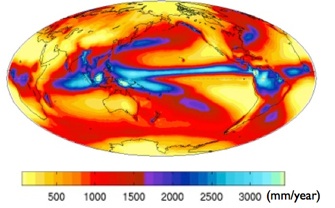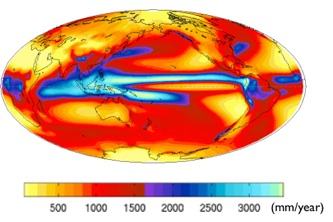Near the equator, approximately between 10N and 10S, the northeasterly and southeasterly trade winds converge in a low-pressure zone. Solar radiation peaks at these latitudes and forces air to rise, resulting in an area with intense and persistent rainfall, with maximum rainfall around 5N (Figure 1). The regions at the boundary of this tropical rain belt, however, experience distinct rainy and dry seasons as the rain belt migrates north and south seasonally and inter-annually. An anomalous variation in the location of the tropical rain belt results in tremendous changes to local rainfall and affects millions of people.
In this series of studies, we attempt to offer a better understanding of what determines the location and displacement of the tropical rain belt. Traditionally, it is often assumed that the position of the tropical rain belt is controlled by tropical mechanisms (1-4). However, recent work in general circulation theory has suggested that one should not only look within the tropics for features that affect tropical precipitation (5, 6). The physical mechanism for extratropical connections is based on energetic constraints, and essentially argues that tropical precipitation shifts towards whichever hemisphere is heated more at the surface or top-of-atmosphere (see a recent review (7)). This theoretical framework is consistent with recent simulations of Last Glacial Maximum conditions (8), water hosing experiments (9, 10), and aerosol cooling simulations (11), which also show large tropical precipitation shifts away from high latitude cooling.


